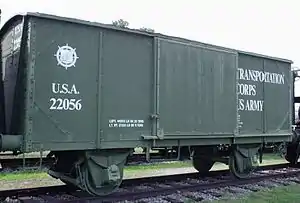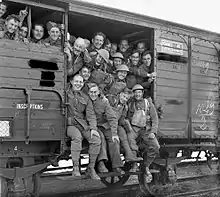Forty-and-eights
Forty-and-eights (French: Quarante et huit, typically written 40/8 or 40&8) were French 4-wheel covered goods wagons designed to hold 40 men or eight horses. Introduced in the 1870s, they were drafted into military service by the French Army in both World Wars. They were also used by the occupying Germans in World War II, followed by the Allies.
| Quarante et huit (Forty-and-eights) | |
|---|---|
 Forty and Eights-style covered goods wagon in the U.S. Army Transportation Museum | |
| Capacity | 40 men or 8 horses or 20 tonnes (19.7 long tons; 22.0 short tons) of supplies |
| Operator(s) | French Army and French railways |
| Specifications | |
| Weight | 7.9 tonnes (7.8 long tons; 8.7 short tons) tare |
| Braking system(s) | Air |
| Coupling system | Buffers and chain |
| Track gauge | 1,435 mm (4 ft 8 1⁄2 in) |
During World War II

Between 1940 and 1944 occupying German forces used Forty-and-eights to transport troops, POWs, horses, freight, and civilian prisoners to concentration camps.
Following the Allied landing at Normandy in June, 1944, the Germans were pushed eastward towards the Rhine. Trains of Forty-and-eights were frequent targets of opportunity for Allied fighter-bombers, with carloads of prisoners occasionally being victimized. As France was liberated Forty-and-eights were used to transport Allied soldiers and materials to the shifting front through War's end in 1945.
Merci Train
In 1949, France sent 49 Forty-and-eights to the United States laden with donations from citizens of France in thanks for the U.S.' role in the liberation of France, one for each of the then forty-eight states and one for Washington, D.C., and Hawaii to share. Called the Merci Train, it was sent in response to the Friendship Train America had created two years earlier to aid France in the dire immediate aftermath of World War II; 700 boxcars worth of donated supplies were collected across the U.S. and shipped across the Atlantic via donated transport.
See also
 Media related to Forty-and-eight boxcars at Wikimedia Commons
Media related to Forty-and-eight boxcars at Wikimedia Commons- Boxcars in wartime use
- SNCF in World War II
- U.S. Army Transportation Museum
External links
- Merci Train
- ThemeTrains.com - The Merci Train
- Merci Box Car of NH
- Alabama's Merci Boxcar at U.S. Veterans Memorial Museum